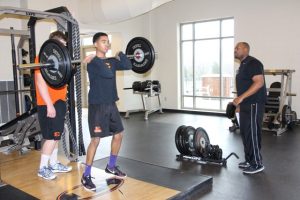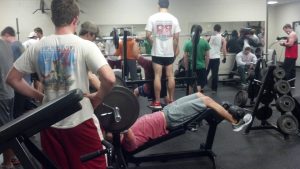I love innovation.
I love new exercise variations. I love learning new methods. I love new technology. It’s fun for me to watch new trends come and go, and I enjoy trying to predict what’s coming. People love throwing around the term “functional” and seem to use it as a blanket reason for anything in their program.
Over the past year, however, it’s been hammered home time and time again that, while function and creativity are great, practicality is one of the most important – and neglected – factors to consider in programming. This is especially true when working with groups, which I do a lot. You can design the greatest program in the world, but if it isn’t practical – if it can’t actually be implemented – it’s not worth the paper it’s written on.
Here is an example. I’ve had a few young coaches contact me about looking at their programs for high school teams before they implement them. I’ll see stuff like this:
Power Clean 5 x 5
Front Squat 5 x 5
RDL 5 x 5
Bench Press 5 x 5
Barbell Row 5 x 5
Machine Front Neck 2 x 10
Machine Back Neck 2 x 10
At first, it looks like a nice, straightforward program, but things start to look a lot different when I find out there will be 40 athletes in the weight room with three racks, five barbells, and just one neck machine. There’s going to be a line out the door waiting for a barbell or the neck machine. It’s going to take two hours to finish a workout that should take less than 60 minutes. It’s not practical. It’s going to be a mess and the coach is going to look like a total amateur.

I also look at that workout and think about where the coaching energy is going to be placed. I would consider every one of these a “high coaching-demand” exercise. High school kids are going to struggle with several of them, so you’re going to be running around trying to correct poor form all day. You’ll have no time to help them understand how to progressively overload each movement or simply motivate the kids. It’s a recipe for disaster and will become a complete cluster based on the exercise choices. It’s a perfect example of a good program that’s simply not practical.
Here’s another example I’ve seen for a workout at a private training facility:
6 x 10 yards acceleration mechanics work
6 x 10 yards sled sprints
3 x 10 squat jumps
3 x 10 split squat jumps
Tabata set of something each day
Clean 3 x 5
Dumbbell Press 3 x 8
Chin ups 3 x 8
Single leg squat 3 x 8
RDL 3 x 8
Core work
Flexibility
When I first saw this, I thought it looked good. I felt like the coach had a good plan….until I started asking questions.
It turns out that he runs 60-minute sessions, there are typically 6-8 athletes in a group and he only has one squat rack and one speed sled.
Uh oh.
Then I found out that he also does a 10-15 warm-up at the beginning of each session. There’s just no way to get all of that done in one hour. Something has to give.
When creating programs, it’s critical to think about how you’re actually going to get it all done. You can’t fit everything you know into one hour (at least I hope not), so pick a few things and get your athletes great at them.
Early in my career, I always wanted to fit everything in and come up with new stuff to show off my creativity. I prided myself on being able to come up with a great workout no matter where I was. While I still think that’s important, I’m now drawn to fundamentals more than ever. I see so many young coaches trying to make their mark on this field by coming up with something new instead of mastering fundamentals. What I’ve learned is that, without mastering the fundamentals, there is no basis for innovation. It’s almost like saying “I’m not very good at the basics, so I’ll come up with something different so nobody will notice.”
I don’t need 50 variations for every movement. I need a couple and I need to understand the most important concept in strength training – systematic & progressive overload. Pick a movement, and get stronger with it.
The basics are not broken. They never were. We’ve just become so used to being entertained, that we’re constantly looking for something new. Our athletes aren’t bored. We are. And, who cares about us? We’re not the focus of the training – our clients are.
If you and your athletes aren’t exceptional at the fundamentals, take a step back and think about what you’re doing. You owe it to yourself, and your clients, to help them develop a sound foundation before moving on to new tricks.
In my world the most important program equation now looks like this:
Practical = Functional

